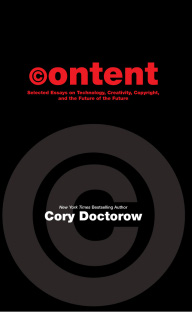Cory Doctorow: Content: Selected Essays on Technology, Creativity, Copyright, and the Future of the Future (2008)
Filed under book | Tags: · copyright, creative commons, culture

Hailed by Bruce Sterling as “a political activist, gizmo freak, junk collector, programmer, entrepreneur, and all-around Renaissance geek,” the Internet’s favorite high-tech culture maven is celebrated with the first collection of his infamous articles, essays, and polemics. Irreverently championing free speech and universal access to information—even if it’s just a free download of the newest Britney Spears MP3—he leads off with a mutinous talk given at Microsoft on digital rights management, insisting that they stop treating their customers as criminals. Readers will discover how America chose Happy Meal toys over copyright, why Facebook is taking a faceplant, how the Internet is basically just a giant Xerox machine, why Wikipedia is a poor cousin of The Hitchhikers Guide to the Galaxy, and how to enjoy free e-books. Practicing what he preaches, all of the author’s books, including this one, are simultaneously released in print and on the Internet under Creative Commons licenses that encourage their reuse and sharing. He argues persuasively that this practice has considerably increased his sales by enlisting readers to promote his work. Accessible to geeks and nontechies alike, this is a timely collection from an author who effortlessly surfs the zeitgeist while always generating his own wave.
Published by Tachyon Publications, 2008
ISBN 1892391813, 9781892391810
224 pages
Jonathan Zittrain: The Future of the Internet. And How to Stop It (2008)
Filed under book | Tags: · copyright, internet, netizens, networks, web 2.0

This extraordinary book explains the engine that has catapulted the Internet from backwater to ubiquity—and reveals that it is sputtering precisely because of its runaway success. With the unwitting help of its users, the generative Internet is on a path to a lockdown, ending its cycle of innovation—and facilitating unsettling new kinds of control.
IPods, iPhones, Xboxes, and TiVos represent the first wave of Internet-centered products that can’t be easily modified by anyone except their vendors or selected partners. These “tethered appliances” have already been used in remarkable but little-known ways: car GPS systems have been reconfigured at the demand of law enforcement to eavesdrop on the occupants at all times, and digital video recorders have been ordered to self-destruct thanks to a lawsuit against the manufacturer thousands of miles away. New Web 2.0 platforms like Google mash-ups and Facebook are rightly touted—but their applications can be similarly monitored and eliminated from a central source. As tethered appliances and applications eclipse the PC, the very nature of the Internet—its “generativity,” or innovative character—is at risk.
The Internet’s current trajectory is one of lost opportunity. Its salvation, Zittrain argues, lies in the hands of its millions of users. Drawing on generative technologies like Wikipedia that have so far survived their own successes, this book shows how to develop new technologies and social structures that allow users to work creatively and collaboratively, participate in solutions, and become true “netizens.”
Published by: Yale University Press, 2008
Creative Commons Attribution Non-Commercial Share-Alike 3.0 license
ISBN 0300124872, 9780300124873
352 pages
PDF (updated on 2013-6-5)
Comment (1)Matt Mason: The Pirate’s Dilemma: How Youth Culture is Reinventing Capitalism (2008)
Filed under book | Tags: · capitalism, copyright, filesharing, graffiti, hip hop, piracy, pirate radio, remix, youth, youtube

It started with punk. Hip-hop, rave, graffiti, and gaming took it to another level, and now modern technology has made the ideas and innovations of youth culture increasingly intimate and increasingly global at the same time.
In The Pirate’s Dilemma, VICE magazine’s Matt Mason — poised to become the Malcolm Gladwell of the iPod Generation — brings the exuberance of a passionate music fan and the technological savvy of an IT wizard to the task of sorting through the changes brought about by the interface of pop culture and innovation. He charts the rise of various youth movements — from pirate radio to remix culture — and tracks their ripple effect throughout larger society. Mason brings a passion and a breadth of intelligence to questions such as the following: How did a male model who messed with disco records in the 1970s influence the way Boeing designs airplanes? Who was the nun who invented dance music, and how is her influence undermining capitalism as we know it? Did three high school kids who remixed Nazis into Smurfs in the 1980s change the future of the video game industry? Can hip-hop really bring about world peace? Each chapter crystallizes the idea behind one of these fringe movements and shows how it combined with technology to subvert old hierarchies and empower the individual.
With great wit and insight — and a cast of characters that includes such icons as the Ramones, Andy Warhol, Madonna, Russell Simmons, and 50 Cent — Mason uncovers the trends that have transformed countercultural scenes into burgeoning global industries and movements, ultimately changing our way of life.
Publisher Free Press, a division of Simon and Schuster, New York, 2008.
ISBN 1416554017, 9781416554011
290 pages
PDF (updated on 2012-8-7)
Comment (0)
